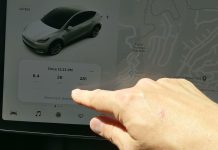Here’s the latest reader question, along with my reply!
Jim asks: I caught your interesting article (here) about setting float level on a carburetor and that made me think about reverting my 1990 Chevy truck to a carburetor. Is this a doable thing and would you recommend doing it? Thanks for all your excellent Diaper coverage, by the way!
My reply: This conversion (reversion) is very easy if you are doing it to a vehicle – like yours – that has a throttle body injection (TBI) system. Most of these have a TBI injector that sits on top of a conventional intake manifold and they work very much like a carb – spraying atomized fuel into the intake, where it is drawn through the runners to the the intake ports/cylinders to be burned. The difference is that the fuel is injected under pressure whereas with the carb it is drawn by engine vacuum into the manifold.
You may be able to bolt a carb directly to your existing manifold; worst case, you replace your factory manifold with one designed for a carb, ideally the carb you plan to use (e.g., a spread bore manifold for a spread-bore carb).
Of course, you will also probably have to nix your computer – which controlled the injection as well as (probably) the ignition. A stand-alone/non-computerized distributor may be needed – but again, no big deal as these are generally drop-in replacements on GM vehicles of that era.
The main issue you’ll have to deal with – maybe – will be emissions inspection. If you have to deal with it. But you can avoid it by registering your vehicle as an antique – which in most states exempts a vehicle from emissions checks. And your ’90 vehicle qualifies as it’s 30 years old (and in most states, a vehicle qualifies for antique tags once it’s 25 years old or older).
The main advantage to doing this reversion is to never have to worry about electronics again – for the most part. The distributor still has some electronic parts, but provided you keep a spare module and so on handy – along with a rebuild kit for the carb – you’ll have everything necessary to keep that vehicle running for another 30 years.
. . .
Got a question about cars, Libertarian politics – or anything else? Click on the “ask Eric” link and send ’em in!
If you like what you’ve found here please consider supporting EPautos.
We depend on you to keep the wheels turning!
Our donate button is here.
If you prefer not to use PayPal, our mailing address is:
EPautos
721 Hummingbird Lane SE
Copper Hill, VA 24079
PS: Get an EPautos magnet or sticker or coaster in return for a $20 or more one-time donation or a $10 or more monthly recurring donation. (Please be sure to tell us you want a magnet or sticker or coaster – and also, provide an address, so we know where to mail the thing!)
If you’d like an ear tag – custom made! – just ask and it will be delivered.
My latest eBook is also available for your favorite price – free! Click here. If that fails, email me at [email protected] and I will send you a copy directly!











It’s possible, but of all systems to retrofit, the TBI SBC would be last on my list. Engine management was computerized, but nothing else in the vehicle was.
Yes, it has a computer… but it’s a good one. It’s tunable, flash-able, re-chip-able, whatever. My late brother-in-law built a sizable business out of TPI systems. Funnily enough, most of it was bolt-on replacements for carbureted SBC engines, with a four wire hookup and a new fuel pump.
If you want to go full post-apocalypse, then a 1-wire diesel is what you want.
As for emissions, most states don’t require anything for pre-’96 (OBD-II) systems. In New Hampshire, even OBD-II vehicles are exempt and can pass with a check engine light if they’re 20+ years old, no antique registry required.
Hi KB,
I agree with you in re TBI systems. They’re pretty simple and provide all the drivability (and low maintenance) benefits of FI without PFI (much less DI). Still, I get not wanting to have anything electronic, to the extent that is possible. In this case, I think it’d be sound policy to have a spare TBI unit, etc. for just in case.
The big plus when it comes to carbs is that they can be rebuilt multiple times. Assuming the castings are sound, a carb can mix fuel for generations, not just decades.
eric, the big plus with TBI is I have NEVER seen one have problems. It’s like they’re a forever part and as long as you keep clean fuel flowing, they’ll work like always. I’ve seen 25 year old pickups with over half a million miles and the original TBI and never had a problem with it. I know from experience, every few years you’ll have to rebuild a carb. The TBI has better low end torque and just as good performance at any rpm. I’d spend money on a TBI repair before I would change to a carb.
Agreed, Eight – though of course the TBI also comes with a computer and that ties into the ignition and other things. I love my Quadrajet. It’s the same one that’s been under the TA’s shaker for lo these almost 50 years now 🙂
@Eight,
I strongly disagree that a factory style TBI will perform as well as a correctly calibrated Qjet in any metric (except meeting emission standards). Carbs needing rebuilt every few years makes me raise an eyebrow as well (my experience with carbs has been much, much better than that).
That said, I am also a proponent of ‘if it ain’t broke, dont fix it’, and TBI setups are known for reliability. I guess it would depend upon the reason for wanting to do a carb swap as to whether or not it is a worthwhile endeavor…
P.S. – most people haven’t a clue when it comes to setting up a carburetor or curving a distributor (or setting timing in general) and that situation isn’t getting any better as time goes on.
dbb, we’ll just have to agree to disagree. I never had a carb of any type that didn’t need a rebuild after a few years or in the case of performance Holley’s, every several months.
But TBI is one of those things that just keeps on keeping on or it has for me. Something, such as the holes where the rods run through a carb will wear out and get so much slack you can’t get them tuned correctly because they are no longer sealed. The first time I had that happen and older and wiser guy showed me why I couldn’t get the tune right. In his words, there’s no part to replace, nothing you can replace so that new control rod will make it like new. Then he showed me what you could do. Set that carb to the side and forget it. You might get lucky and find one just exactly the same and use the new parts in a good body and be back to
the old howl. FWIW, you can do some fancy lid modifying on a TBI and it’s hard to tell them apart.
The biggest reason I’ll take TBI is low end torque. You never even notice the a/c or any other accesory
Another thing about TBI is it will fit whatever style of intake you want and you can get them in various sizes and get them matched to either the original ignition or an HEI. Put the right size TBI on eric’s T/A and it’ll have that same moan as the QJ.
Anyone who’s been around here for very long knows I’m old school but the TBI is NOW old school and you can change the computer or buy an aftermarket that will outperform a QJ. Of course if I had a QJ, I wouldn’t change it for a TBI unless I was looking for a better power curve but wouldn’t bother on a fairly stock engine.
“…or buy an aftermarket that will [perform as well as] a QJ.”
fixed it for ya lol 😉
FWIW a good carb can cost just as much as an F.I. conversion…
Exactly. I can buy a good TBI unit for less than the latest 4 barrel carb and the carb is more complicated.
Hi Eight,
I’m betting you a ribeye that you’ve got at least two spare Quadrajets in a drawer someplace! Disclosure: I have three of them. Also a set of Keihins and a few others . . . somewhere in my mess!
Next you’ll bet me I have buckets of alternators, starters(nearly all BB since just changing the nosepiece for a small block gets you a much stronger starter and you’ll probably call me out on distributors, intake manifolds and header systems. I decline that bet.
Hi DirtyBob,
This is true – if you buy a new carb. But if you have a rebuildable one, you can bring it back to functional as new for about $50 – the cost of a rebuild kit. I’ve been playing with Quadrajets in particular since I was a teenager and still have some of the ones I played with as a not-much-older. I am a lot older now – and they still work! God only knows how much longer I will!
Well, I was thinking along the lines of Braswell, SMI, DeVane, etc… when I said “a good carb”.
They’re worth the money – in the right (esp. when not stock) application.
In the case of Qjets (as you probably know already) it can get a bit tricky if the factory calibration isn’t close for the combo you have. It gets even worse when you have a low vacuum signal and some intake reversion going on.
Might want to look at a (return style) fuel pressure regulator. IIRC the TBI setups would make 15+ psi – a bit too much for a carbed application.
Pretty sure the TBI intake manifold won’t accept a carburetor, I know the one I have sitting here on my basement floor won’t.
If running a 700r4/4l60, pay attention to the TV cable bracket and lockup controls.